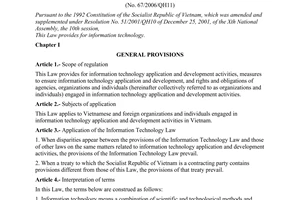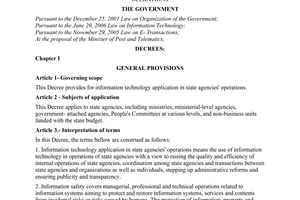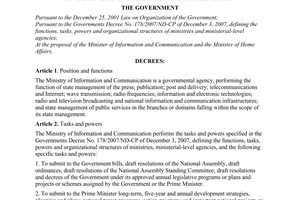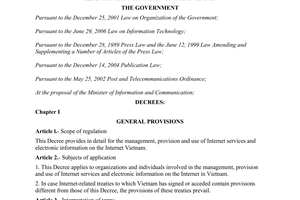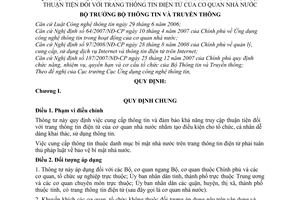Nội dung toàn văn 26/2009/TT-BTTTT
|
THE
MINISTER OF INFORMATION AND COMMUNICATIONS |
SOCIALIST
REPUBLIC OF VIET NAM |
|
No. 26/2009/TT-BTTTT |
Hanoi, July 31, 2009 |
CIRCULAR
PROVIDING FOR THE PROVISION OF INFORMATION AND ASSURANCE OF CONVENIENT ACCESS TO WEBSITES OF STATE AGENCIES
THE MINISTER OF INFORMATION AND COMMUNICATIONS
Pursuant to the June 29, 2006
Information Technology Law;
Pursuant to the Government's Decree No. 64/2007/ND-CP of April 10, 2007, on the
application of information technology to stale agencies' operations;
Pursuant to the Government's Decree No. 97/2008/ND-CP of August 28, 2008, on
the management, provision and use of Internet services and supply of
information on the Internet;
Pursuant to the Government's Decree No. 187/2007/ND-CP of December 25, 2007,
defining the functions, tasks, powers and organizational structure of Ministry
of Information and Communications;
At the proposal of the Director of the Information Technology Application
Department,
STIPULATES:
Chapter I
GENERAL PROVISIONS
Article 1. Scope of regulation
This Circular provides for the provision of information on and assurance of convenient access to websites of state agencies in order to facilitate the exploitation and use of information by organizations and individuals.
The provision of information of the list of state secrets on websites must comply with laws on protection of state secrets.
Article 2. Subjects of application
1. This Circular applies to ministries, ministerial-level agencies, government-attached agencies and their dependent non-business agencies and organizations: provincial-level People's Committees and their dependent specialized agencies; and district-level People's Committees which have their own websites (below referred to as state agencies).
2. Agencies and organizations other than above-mentioned entities are encouraged to apply this Circular in an appropriate manner.
Article 3. Interpretation of terms
In this Circular, the terms below are construed as follows:
1. Public administrative services are not-for-profit law enforcement-related services provided by competent state agencies (or authorized organizations and enterprises) to organizations and individuals in the form of papers of legal validity in domains managed by these agencies.
2. Online public services are public administrative services and other services provided online by state agencies to organizations and individuals.
3. Grade-1 online public services are the services of providing sufficient information on procedures and dossiers, time limits: and charges-and fees for the provision of services.
4. Grade-2 online public services are grade-1 online public services which also enable users to download forms of documents for declaration and completion of dossiers as requested. After being completed, dossiers shall be submitted directly or sent by post to service providers.
5. Grade-3 online public services are grade-2 online public services which also enable users to fill in and send online forms of documents to service providers. Transactions in the process of handling dossiers and providing services will be carried out online. The payment of charges (if any) and receipt of replies will be made at service providers.
6. Grade-4 online public services are grade-3 online public services which also enable users to pay charges (if any) online. Replies may be received online or delivered directly or sent by post to service users.
7. Web page is a document written in HTML or XHTML and located on the World Wide Web via a unique and fixed address called URL. A website may be made of one or several hyperlinked pages.
8. Home page is the first page which users see when they access a website at its address registered by and allocated to the organization or individual.
Chapter II
PROVISION OF INFORMATION ON WEBSITES
Article 4. Principal information
1. Principal information specified in Clause 2, Article 28 of the Law on Information Technology must cover at least the following details:
a/ Information on the organization, functions, tasks and powers of the agency and each of its dependent units:
- The organizational structure;
- Functions, tasks and powers of each dependent agency or unit;
- A summary of the formation and development process;
- Full names, positions, telephone numbers, official email addresses and tasks of leaders of each unit;
- Contact information: addresses, telephone numbers, fax numbers and official email addresses for contact and receipt of information.
b/ Specialized legal documents and relevant administrative management documents: the form of documents, promulgating competence, code, date of promulgation, effective date, subject matter and downloadable files.
c/ Information on administrative procedures:
- A list of public administrative services and online public services currently provided;
- Administrative processes and procedures, dossiers, place of receipt, name and contact information of persons directly handling dossiers, time limits for settlement, charges and fees (if any);
- The grade of online public services.
d/ Information involved in dissemination, popularization and guidance of the implementation of specialized laws, regimes, policies, strategies and plannings: full texts of specialized regimes, policies, strategies and plannings.
e/ A list of official email addresses of each dependent unit and competent cadres and public employees: their full names, positions, telephone numbers and official email addresses.
f/ Information on investment projects and items, bidding and public procurement:
- A list of projects under investment preparation, ongoing projects and completed projects;
- For each project, it is required to provide at least the following information: name of the project, principal objectives, operational domain, type of the project, implementation duration, method of financing, financiers and project status.
g/ The feedback section:
- A list of matters posted up for public opinion (legal documents and policies);
- For each matter posted up for public opinion, it is required to provide information on the time limit for receipt of opinions and the full text of the document put up for public opinion, contributed comments and receipt of new comments.
2. State agencies shall, within the scope of their competence, proactively publicize information on their direction and administration activities, including directing and administering opinions of heads of state management agencies: replies to feedbacks and proposals of organizations and individuals; information on commendation and sanctioning of individuals, collectives and enterprises; and specialized statistical information.
Article 5. Information in service of search and reference activities
1. For web pages, it is required to have at least the following information: page title, keywords and descriptions for search purposes.
2. For each news or article, there must be information on the author, source of information and updating time.
Article 6. Foreign-language information
1. Websites of ministries, ministerial-level agencies, government-attached agencies and provincial-level People's Committees must additionally contain at least information defined at Points a and c, Clause 1, Article 4 of this Circular (for online public services related to foreigners) in English.
2. State agencies shall take the initiative in providing information defined at Point d. Clause I. Article 4 of this Circular and information on historical, geographical and cultural characteristics, people, economic and tourist potential in English and other languages.
Chapter III
ASSURANCE OF CONVENIENT ACCESS
Article 7. Minimum properties
1. Displaying principal information defined in Article 4 of this Circular.
2. Searching information: to be able to adequately and accurately search information, news and articles available on the website.
3. Displaying the site map: to adequately and accurately express the tree-like structure of information sections of the website and assure the correct link to relevant information sections or properties.
4. Receiving information from and making replies to organizations and individuals.
5. Providing links to the home page, introduction/contact section and site map at each page.
6. Printing and storing information: Users may print the whole page or print a news or article in the portrait format or other types of format set up in their printers on A4 paper. It is encouraged to have the property which facilitates the storage of news and articles in storage devices according to standards on documents specified in the Information and Communications Minister's Decision No. 20/2008/QD-BTTTT of April 9. 2008.
Article 8. Interface and layout
1. A website must be user-friendly with information sections clearly distinguished from one another.
2. The sector of principal information defined in Article 4 of this Circular must be arranged at a noticeable position on the home page.
3. Layout of the homepage of a website:
The home page of a website has five parts: the header at the top position of the page; the left column; the right column, the central column and the footer.
a/ The header of the page contain a banner and a horizontal menu bar:
The banner lays in the top position of the home page with the following principal details: the logo of the agency or the national emblem and the full name of the agency in Vietnamese in regular font. The banner information must be kept unchanged when users search the website or portal;
The horizontal menu bar lays below the banner, expressing such properties as returning to the home page, prominent column, site map, contact address, language conversion and other properties.
b/ The left column shows links to the main sections such as introduction about the agency, news and events, online public services, receipt of feedback, reference to legal documents, website search and links, statistics on access to the website and other sections.
c/ The right column shows links to such sections as: latest news, prominent events, notification and separate sections of the agency, advertisements and other sections.
d/ The central column lays in the center of the home page, showing headlines of major and selected news and articles or information on sections or properties selected by users and a text showing the link from the outer section to the current section for visitors to know what section they are viewing.
e/ The footer of the page shows information on copyright and the state agency managing the website, covering such details as the name of the agency, administrators, address, telephone number and email address.
Article 9. Assurance of consistency and conformity with standards and bandwidth
1. The Vietnamese character code Unicode under Vietnam standard TCVN 6909: 2001 must be used.
2. Sound and image data and downloadable files provided on websites must comply with standards on application of information technology in state agencies specified in the Information and Communications Ministry's Decision No. 20/2008/QD-BTTTT of April 9, 2008.
3. Images at websites should have a size of less than 30 KB. For images of a larger size, a scrollbar should be used to link to a new page in order to display images in a larger size.
4. The total maximum capacity (including contents and attached files, if any. containing HTML. XHTML or JavaScript code, sound, image) to be downloaded to fully display an information page on users' computer should be less than 500 KB.
Article 10. Supporting access to information by people with disabilities
1. It must be ensured that all properties can be performed with the keyboard and shortcut keys will be created to access to the minimum properties of the website (the homepage, site map. search and instruction). It is encouraged to integrate on the website technologies to support the access to information by people with disabilities.
2. To use suitable colors and contrast. There must be a sharp contrast between the background color and the character color so as to support color-blind people. To refrain from using color to highlight text within a paragraph. To encourage the application of properties which allow users to change the color of the background and the character and the contrast between the background color and the character color.
3. To provide equivalent information: It is necessary to provide text to describe the contents of objects other than text such as icons, images, confirmation key, art fonts, charts, diagrams and image linking and text describing the major contents of audio and video news.
4. To refrain from using flickering characters or objects and automatically moving characters so as to use browsing programs when necessary.
5. To display data tables:
a/ To supply brief information on all data tables to describe data and titles of these tables;
b/ To use tagging techniques to link data boxes to equivalent title boxes, for data tables with lines and column of different logical levels;
c/ To refrain from using tables to fix a web page.
6. Information orientations
a/ To use meaningful phrases to make a link or use title attributes to provide additional information to clarify or describe the purposes of a link:
b/ To use heading attributes to divide different information sections on a web page.
Chapter IV
ASSURANCE OF OPERATION OF WEBSITES
Article 11. Assurance of human resources
1. Heads of state agencies specified at Clause 1. Article 2 of this Circular shall direct the organization and operation of websites.
2. State agencies shall ensure adequate personnel for:
a/ Administering their websites, including management, operation and maintenance. Administrators must be annually trained in and updated with new knowledge on information management, technology and techniques.
b/ Editing information to be posted on their websites. Editors must possess journalistic skills to handle and provide information.
Article 12. Time and frequency of updating information to websites
1. Information must be updated at least once a day during weekdays: while on weekends, it is encouraged to regularly update information on websites.
Information specified in Article 4 and foreign-language information specified in Article 6 must be regularly reviewed and updated upon occurrence of changes.
2. Time for supplying information:
a/ For legal documents issued by agencies themselves: within 2 working days after the date of signing.
b/ For news and events: to promptly provide information while on ongoing activities or events. 3. Handling of feedback:
a/ State agencies shall assign a contact unit to receive opinions and feedback sent via the websites or e-mail addresses used to receive opinions and feedback: forward opinions and feedback to units assigned to make replies; and immediately send receipt information to organizations and individuals;
b/ The contact unit shall perform jobs specified at Point a. Clause 3. Article 12 of this Circular at least once every working day;
c/ Within 10 working days after receiving opinions and feedback, state agencies shall issue replies or notify the process of handling these opinions and feedback to concerned organizations and individuals.
Article 13. Assurance of information and data safety
1. To assure the safety and confidentiality at different levels: network safety, authenticity of users and database safety.
2. Data authentication and encoding:
a/ To adopt mechanisms to authenticate and permit access and encode information and data in service of access to information and services for which identification of users is required in order to ensure the safety of websites in the process of exploitation and operation;
b/ The mechanisms of information and data authentication and encoding comply with standards on information safety specified in the Information and Communications Minister's Decision No. 20/2008/QD-BTTTT of April 9. 2008.
3. Data backup:
a/ To conduct data backup on a periodical basis (at least once a week) in order to secure quick resumption of operation of the system upon occurrence of incidents:
b/ Minimum data for which backup is required: data on the configuration of the system (management of users; configuration for setting up other information channels); content storage databases and other relevant data.
Article 14. Maintenance, upgrading and repair of websites
1. Websites must be regularly inspected, maintained and repaired and supervised in order to ensure uninterrupted operation for 24 hours a day.
2. Websites must be reviewed on an annual basis in order to propose plans on upgrading and adjustment to suit practical demands.
Article 15. Responsibilities of state agencies
1. To invest in the development of their websites in accordance with the plan on application of information technology in state agencies' operations and development of an e-government.
2. To ensure adequate funds for the regular creation and updating of information on and annual maintenance of their websites.
3. To widely disseminate information on their websites to the public, encourage and promote creativeness in the management, maintenance and exploitation of websites.
4. To formulate regulations on administration and operation of and provision of information on their websites.
Chapter V
ORGANIZATION OF IMPLEMENTATION
Article 16. Responsibilities of related units
1. The Information Technology Application Department of the Ministry of Information and Communications shall propagate and guide the implementation of this Circular; annually evaluate and rank websites of ministries, ministerial-level agencies, government-attached agencies and provincial-level People's Committees.
2. The Science and Technology Department of the Ministry of Information and Communications shall study, formulate and propose the promulgation of standards and technical regulations on the design, formulation, development, operation, use, updating and repair of websites.
3. Provincial-level Information and Communications Departments shall propagate, disseminate and guide the implementation of this Circular to state agencies.
4. Information technology units under ministries, ministerial-level agencies and government-attached agencies shall guide the implementation of this Circular to attached units.
Article 17. Effect
1. This Circular takes effect on September 15, 2009.
2. Any problems arising in the course of implementation should be promptly reported to the Ministry of Information and Communications for consideration, supplementation and amendment.
|
|
MINISTER
OF |
